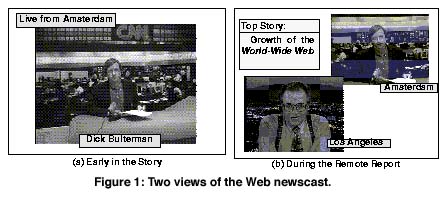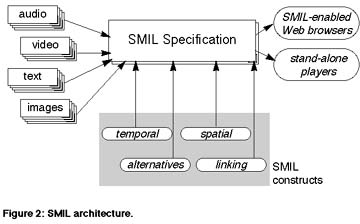Authoring Multimedia for the Web
by Henk Nieland
The W3C working group on synchronized multimedia SYMM is in the process of developing a declarative specification language SMIL (Synchronized Multimedia Integration Language). SMIL does not specify any particular playback or authoring environment functionality. At CWI, a SYMM participant, an authoring environment GRiNS is developed which, in combination with a browser, will enable users to discover SMIL's potential.
The World Wide Web, generally seen as the embodiment of the infra-structure of today's information age, is currently unable to handle documents containing continuous media such as audio and video in a user-friendly way. This is mainly due to the lack of easy-to-use synchronization support in Web documents.
Early in 1997, the W3C working group SYMM was established to study the
definition of a declarative multimedia format for the Web. In such a format,
the control interactions required for multimedia applications are encoded
in a text file as a structured set of object relations. A declarative specification
is often easier to edit and maintain than a program-based specification,
and it can potentially provide a greater degree of accessibility to the
network infrastructure by reducing the amount of programming required for
creating any particular presentation (the first system to propose such
a format for network use was CMIF, developed at CWI). The SMIL specification
language describes four fundamental aspects of a multimedia presentation:
temporal specifications (timing), spatial specifications (layout), alternative
behaviour specification (optional user requirements), and hypermedia support
(linking).


The CMIFed authoring system, associated with CMIF, formed the basis of the authoring system GRiNS (a graphical interface for SMIL), recently developed at CWI. GRiNS is an authoring and presentation system for SMIL documents. It is a part of the CHAMELEON multimedia document processing suite. GRiNS consists of an authoring interface and a runtime player which can be used to create SMIL documents suitable for playing on any SMIL-compliant browser or stand-alone player; the GRiNS player can take any SMIL document and render it using a stand-alone player. The GRiNS authoring environment supports creation of a SMIL document in terms of three views: the logical structure view (coarse-grain timing), the virtual timeline view (fine-grain timing) , and the playout view (layout projections). It includes a playout engine conforming to the SMIL working draft. More information on SYMM at: http://www.w3.org/AudioVideo/Overview.html
Please contact:
Dick Bulterman - CWI
Tel: +31 20 592 4147
E-mail: Dick.Bulterman@cwi.nl
